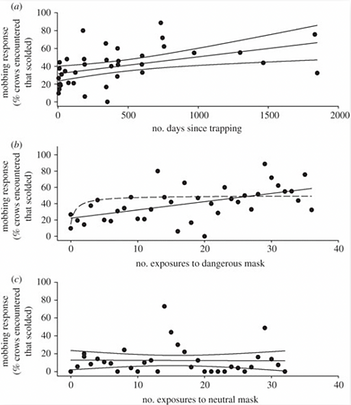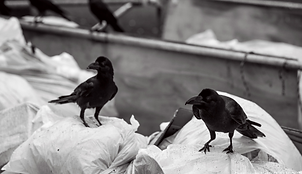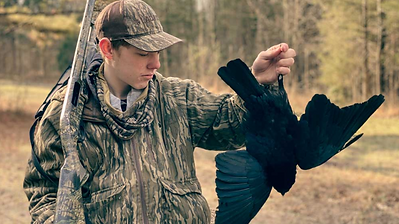Writing Showcase
On this page you will find two of my writing works that I created for this class. Both of these pieces showcase how much I have grown as a writer! The first is my Scicomm Article, the second my Advocacy Project.

Scicomm Article
This article was based off a research study on the reasonings behind why crows hold funerals. It goes into detail about what crow funerals look and sound like. It also includes narrative elements to keep the audience engaged and willing to learn about scientific research on crows.
After writing this article, I found that I became a better and more efficient writer. It allowed me to understand the importance of engaging your reader into the text, no matter what the content is. Turning scientific content into a more understandable text now comes much easier to me.

Check out my article: Have You Ever Attended a Crow Funeral?
Advocacy Project
This project used all of my research expertise that I have gained throughout the quarter to create an online multimedia article that advocates for my chosen animal of crows. I focused on a specific problem that crows face, and advocated for solutions to this problem. My writing includes narrative elements, interactive multimedia items, and scientific research to get my point across.

The Witty Side of the Frightening Crow
Are crows as scary as they seem? Or are they just playful creatures who like to be mischievous?



A murder of crows swoops together in the air, screeching noisily in mix-matched sounds that irritate the ear. They endlessly circle around up in the sky, for what seems like decades. What are they doing up there? Plotting deaths? Bringing us bad luck?
As scary as you think a murder of crows is, they really are just intelligent, social, and playful creatures who have a number of similarities to us, yet happen to be constantly portrayed as frightening. This misunderstanding of crows as evil creatures leads many to not care about them, even when farmers kill them because they get upset at the messes they can make in agricultural crops or gardens.
Figure 1. A murder of crows flying in the sky. From Jesse McNeil's Huge Murder of Crows! video on Youtube.
WHAT MAKES CROWS SPECIAL?
People will often attempt to insult someone by declaring that they have a "bird brain", but what if I told you that having a "bird brain" is actually a compliment? Crows have brains that are quite large for their body size. According to crow expert researcher John Marzluff in his Crows, smarter than you think TED Talk, he would "like to think of these animals as small flying monkeys, rather than flying birds" (4:30).
In addition to their intelligent brains, crows hold very social lives with complex relationships. Just like us, they have both nuclear and extended family members. Crow parents will mate and build families, staying together for life. In "The Young and the Restless: Watching Neighborhood Crows", Andrea Townsend mentions how some members of a crow family will even adopt young crows from unrelated neighbors!

Figure 2. Comic of a crow's high intelligence. From Exploding Kittens post on Facebook.
Crows like to chat with one another, just like we do. At the University of Washington in 2011, John Marzluff conducted a research study to learn more about crows' social lives. His article, "Social learning spreads knowledge about dangerous humans among American crows", tells us how he captured, banded, and then released crows at five different sites in Washington. He did the capturing with a so-called "dangerous" mask on his face. Unsurpisingly, he found that after the crows were released, they taught their neighbors and family about this mask that resembled danger. This teaching went on and still continues to go on today, to the point where almost all the birds in the research site will scold the mask when seen.

Figure 3. Amount of scolding by crows in response to neutral and dangerous mask and number of days since trapping. From Results section in this study.
Our similarities with crows don't just stop there. Young crows will often engage in play, just as our children do. Avian behavioral ecologist Kaeli Swift tells us in her "Crow curiosities: Do crows play and why" blog post about the numerous types of play crows will engage in. They will play with objects, engage in aerial acrobatics, and hang off branches. Swift presumes that crows benefit from playing with their peers by gaining new experiences, honing their stress, and enlarging their brains!
Figure 4. Crows playing and sledding down a snowy car. From Meanwhile in Russia's video on Youtube.
THE PROBLEM OF NEGATIVE MISCONCEPTIONS
Yet, crows have been under the reputation as "bad" for centuries. Humans have feared them as a sign of bad luck and death. This problem of crows being viewed as evil seems to have been common since medieval times. Writer Emileigh Clare in her "Scientist John Marzluff Knows the Fear of Crows" article tells us that in the 1300s, "the bubonic plague was thought to be spread by the birds, and humans reacted to them with fear and loathing". However, the plague wasn't actually spread by crows, people just liked to associate crows with death.

Figure 5. Infographic on why people hate crows. From an infographic that I created.
Nowadays, crows still have negative connotations in the media. They often get featured in movies as a sign of bad omen or death, and are quite common in horror movies. They may be affiliated with these grim subjects because of their dark outward appearance that is composed of black feathers.
People get frustrated at the intelligence and wittiness of crows. Farmers hate how crows will scavenge their crops and create messes in the fields. Youtuber Tom Pemberton in his video titled "WHY FARMERS HATE CROWS!!" expresses his annoyance of crows poking holes in huge barrels, calling them "horrible animals" (1:42).

Figure 6. Image of a creepy crow. From an image from tvtropes Creepy Crows blog.
Additional frustration of crows comes from those who live in urban cities. As crows have adapted to survive in our growing industrial cities, crow populations have tended to echo human ones. The increasing population of crows in urban areas angers many, because as they scavenge for food they can create messes in our trash. The Massachusetts Audubon Society tells us that "in residential areas, crows have learned to tear open trash bags placed on the curb prior to rubbish day and to 'rototill' lawns in search of grubs".

Figure 7. Image of crows searching trash. From the article Is Our Food Waste Creating a Murder of Crows? by The Revelator.
UNNECESSARY/UNETHICAL HUNTING OF CROWS
This unnecessary hatred and misunderstanding that crows are "evil pests" has led people to poison and kill them. Believe it or not, hunting crows is actually legal in the United States if you have valid reasons or a license. The regulations of American Crows states that "except in the State of Hawaii, where no crows shall be taken, States may by statute or regulation prescribe a hunting season for crows".

Hunting crows is illegal in Hawaii because it's crows are extinct in the wild from habitat loss caused by human colonization. Wildlife biologist Jon Giffin ran a research study on the Hawaiian crow back in 1987, entitled "Habitat Selection and Management of the Hawaiian Crow". It found that great efforts must be made by humans to help preserve this species in habitats that it can thrive in. Today, the bird is still extinct in the wild, but it is surviving in conservation areas. Reintroduction programs are underway and scientists hope to release them into the wild soon. It is crucial that once released, the hunting of them continues to be illegal in Hawaii.
Figure 8. Image of a boy hunting crows. From an image from Brodie Swisher's Hunting Crows on the Winter Migration article.

Figure 9. Graph of the number of Hawaiian crows on the Hualalai island from 1974-85. From the Methods section of this study, page 487.
In all states other than Hawaii, farmers will often hunt crows because they view them as pests and are annoyed at their scavenging behaviors in their crops. An organization named "Crow Busters" pushes all hunters to start hunting and killing this species. They argue that the recent increase of crow populations means that hunters need to hunt these "pests" even more than before.
Data on the number of crows killed each year is difficult to obtain because hunters aren't always required to report small game, but John R Cammidge states in his "History of the Crow" that it is estimated that around 35,000 crows were killed in 2015 by hunters.
Swift shows us in one of her blogs entitled "Portland crow poisoning: When is it legal to kill crows and how do we build empathy?" that people will also kill crows with poison. She tells us about the "likely deliberate killing of at least 30 birds in downtown Portland, OR" in 2014.

Figure 10. Image of a crow hunter. From James Howard's Crow Hunting page on his website.
HOW DO THESE KILLINGS AFFECT US?
Not only are all these killings unethical, but they are hurting us and our environment. Contrary to what many farmers think, crows will actually eat pests who live in their crops: caterpillars, army worms, and other insects. Additionally, as World Atlas says in their "Why are Crows Important to the Ecosystem" article, they "also act as pollinators by transporting pollen from one plant to another". Crows are vital to our ecosystem, and their scavenger behaviors can benefit us. They will "consume tons of waste every year, preventing the spread of diseases and bad odor".


Figure 11. Image of cute crows. From Emma Levey's post on Pinterest.
If we continue to kill crows without blinking an eye, think about how much of an effect that will have on numerous ecosystems. As with any other animal species, crows are intertwined with countless other organisms. The killing of crows is bound to have negative effects on both animals and us humans. Without crows, there would be no one to clean up dead animals and garbage, and we would have an increase in pest insects, because crows eat them.
So what can we do instead of killing crows if we feel that they are being nuisances in our gardens?
Figure 12. Image of an ecosystem with crows. From The Science of Ecology, created by CK-12.
HUMANE SOLUTIONS/ALTERNATIVES TO KILLING CROWS
To solve this issue, we can take both global and grassroots steps. Farmers can use more ethical and effective tactics to crows causing issues on their fields. Additionally, individuals can help solve this issue by educating others about the intelligence and importance of crows, specifically through social media.

The Humane Society of the United States, an organization that focuses on protecting all animals and ending their suffering from human actions, proposed humane solutions to help stop the unnecessary killing of crows. On their "What to do about crows" page, they convince readers about the cruelty of poisoning crows, stating that not only is poisoning crows unethical and unnecessary, but it doesn't even work. Killing them "doesn't cause the survivors to leave town. It merely allows more of the next season's young to survive due to less competition for resources".

Figure 13. Image of a distraught crow seeing a dead friend. From Kaeli Swift's Why crows gather around their dead blog.
The Humane Society tells us that you can drape bird netting over plants, protect seedlings with fabric row covers, and stretch cords above the plants with reflective tape to get rid of crows. These methods are more ethical and efficient than attempting to killing or poisoning them. Adopting these humane approaches will lessen crow-human conflicts in gardens by managing crow populations while still respecting their important ecosystem roles.
Avian Enterprises, a company in Florida that works to effectively get rid of "pest" birds without harming them, expands on this solution. On their "How to Get Rid of Crows" page, they explain that predator decoys such as lifelike owls or hawks are highly effective because "crows are naturally wary of these potential threats".
On top of that, this company mentions how useful audio and visual crow deterrents are. Using audio to remove crows from an area will involve recordings of distress or predator calls. This is a very effective tactic because "the variety and realistic nature of these sounds create an atmosphere of danger, making crows uneasy and less likely to stay in the area". On the other hand, visual crow deterrents will involve reflective surfaces, flashing lights, and moving objects. Providing defense against crows by engaging multiple senses, these tactics will discourage crow presence while "offering an environmentally friendly and non-lethal solution to crow-related issues".
Figure 14. Image of a garden with protective netting. From Garden Gate's The Best Garden Netting article.

Figure 15. Image of an owl decoy. From Home Depot's Bird x Prowler Owl.
Killing any type of animal is always unethical, no matter the reason. Killing crows isn't an effective solution to crow conflicts. Killing them does not mean that they will be gone forever, as the young will end up coming back. Instead, it is critical to use more humane and efficient methods that will move crow populations away from the crops as they search for different and more natural food sources.
THE EFFECTS OF CROW EDUCATION
If individuals want to make a difference in human-crow conflicts, they can always advocate for the education of crows. Teaching others about this amazing species will help minimize negative misconceptions about this bird, thus lessening the amount of people who see no wrong in killing crows.
Creature Conserve, an organization dedicated to wildlife conservation, tells us on their Crow Conservation page that "seeking scientific-based information and raising awareness" can help manage crow conflicts.

Figure 15. Image of a crow teaching. From Drawception's Crow Teacher game.
A strong scientific backed resource to educate people on crows is Swift's blog page on being a crow expert and avian behavioral ecologist. Her website contains vital information about crows behaviors, intelligence, family life, and more. It also includes her scientific research and experiments on corvids.
Social media is an additional critical tool to help educate people on crows. In our ever expanding technological world, communicating to others through social media has become even more vital. It is a great way to reach mass audiences and fight for change.
In my own experience, I have been able to reach numerous twitter users about problems that crows face by posting about it on my twitter account. Posting on twitter can quickly change people's perceptions on them for the better.

Figure 16. Image of my twitter post that reached a number of people. From Ava Taylor's twitter post.
FINAL TAKEAWAYS
Crows are such stunning creatures. Their intelligence, complex social lives, and many similarities to us are all so astonishing. Yet, we find that they are misunderstood animals who are portrayed by popular culture as evil monsters.
This misconceived negative connotation of crows has led people to believe that killing crows is okay. Farmers often will hunt crows because they are causing problems in their crops. This is both unethical and unnecessary.
We must use more humane methods to get rid of crows that are causing problems on farms. This saves both crows and us humans, as crows are important to our ecosystems.
So instead of being afraid of these witty crows, why not fascinate upon their mischevious ways and appreciate their insane intelligence?

Figure 17. Image of a cute crow. From tokaiistudio's Cute crow bird cartoon standing on Freepik.
WORKS CITED
Clare, Emileigh. "Scientist John Marzluff Knows the Fears of the Crow." American Association for the Advancement of Science, 28 October 2020,
Cornell Heather N., Marzluff John M., and Pecoraro Shannon. "Social learning spreads knowledge about dangerous humans among American crows." 2012,
https://royalsocietypublishing.org/doi/10.1098/rspb.2011.0957
"Crows, smarter than you think l John Marzluff l TEDxRainer." Youtube, uploaded by TEDxTalks, 22 January 2014,
https://www.youtube.com/watch?v=0fiAoqwsc9g
Giffin, Jon. "Habitat Selection and Management of the Hawaiian Crow." April 1987,
https://www.jstor.org/stable/3801038
Swift, Kaeli. "Crow curiosities: Do crows play and why." Corvid Research, 16 March 2015,
https://corvidresearch.blog/2015/03/16/crow-curiosities-do-crows-play-and-why/
Mass Audubon. "Crows."
Townsend, Andrea. "The Young and the Restless: Watching Neighborhood Crows." All About Birds, 15 January 2010,
https://www.allaboutbirds.org/news/the-young-and-the-restless-watching-neighborhood-crows/#
"WHY FARMERS HATE CROWS!" Youtube, uploaded by Tom Pemberton, 18 August 2020,
https://www.youtube.com/watch?v=ATlgX5W5z04
Cammidge, John. "History of the Crow." 7 April 2021,
https://johnrcammidge.com/history-of-crows/
Swift, Kaeli. "Portland crow poisoning: When is it legal to kill crows and how do we build empathy?" 14 December 2014,
https://corvidresearch.blog/tag/legal-to-kill-crows/
Kiprop, Victor. "Why Are Crows Important to the Ecosystem?" World Atlas, 25 December 2018,
https://www.worldatlas.com/articles/why-are-crows-important-to-the-ecosystem.html
The Humane Society. "What to do about crows."
https://www.humanesociety.org/resources/what-do-about-crows
Dalvi, Mrinmayi. "Crow Conservation." Creature Conserve, April 2023,